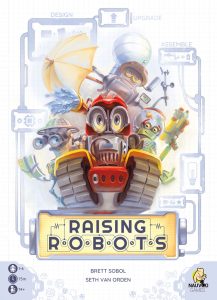 Have you ever wanted to raise a robot? Me neither. Three kids are more than enough for this guy. But have you ever wanted to BUILD your own robot? Again, no. I don’t have time to go back to school for engineering. Oh yeah, and programming as well, and that has its own negatives, like creating Skynet. This is too stressful…
Have you ever wanted to raise a robot? Me neither. Three kids are more than enough for this guy. But have you ever wanted to BUILD your own robot? Again, no. I don’t have time to go back to school for engineering. Oh yeah, and programming as well, and that has its own negatives, like creating Skynet. This is too stressful…
Then it arrived on my doorstep. What I call “The Answer.” Raising Robots… the board game. This could let me build robots without having to go back to school or ending the world. It could simulate all the fun with none of the responsibility, which reminds me… I really miss my 20’s.
Ok, enough with the nostalgia/regret. All that matters, and all you care about as the reader, is “is it a good game?” Yes, with a few caveats. I know, I spoiled my own review. That’s ok. You can just trust me and go buy the game or read on to see why I liked it.
Gameplay Overview:
Raising Robots, published by Nauvoo Games, is a competitive, tableau-building card game that is a marriage between Wing/Wyrm/Finspan and role selection (like Race for the Galaxy, but more on that later). One to six young inventors compete to build the best robots while simultaneously maintaining their grades at school (anxiety… increasing…), with games lasting between 60 and 120 minutes, depending on the number of players and their experience with the game. Note that the game has a considerable amount of simultaneous play, so as you gain more experience, games will be on the shorter side of that spectrum.
Raising Robots lasts for eight rounds. A round consists of three steps:
• Round Preparation – Each player flips over two of their energy cards, adds an energy cube to the card if the symbol is present, and secretly assigns two of their phase cards (one to each energy card). Once all phase cards are assigned, they are revealed, and energy cubes are placed on the phases the energy cards were assigned.
• Round Phases – Players SIMULTANEOUSLY complete the two phases they assigned, plus all phases that have an energy cube. The five phases are:
o Upgrade – improve your player board and a robot, a class grade, or your inventor
o Assemble – pay resources to do what we are here to do – build robots!
o Design/Fabricate/Recycle – these three phases do the same thing – generate resources and VPs, as well as run the matching row (ala the Span series)
• Round End – end of round cleanup (the boring part, except if you have end of round abilities)
At the end of the eight rounds, victory points are tallied, and the player with the most points is crowned “Best Robot Builder Ever.”

Game Experience:
What made me want to go back to school to become an engineer:
Obviously, we are here to build robots, and there sure is a pile of them. Ninety-six to be exact, each with a unique combination of costs, VP value, and abilities. They can be placed in one of three rows, and these rows create the engine that generates your resources and points. When assembling robots, each robot has two different construction costs: a lower energy cost, which requires more resources to build, or a higher energy cost, which requires fewer resources. Additionally, you can split your energy generated to allow you to build more than one robot during that phase.

Trying to decide how to best utilize your energy in combination with the resources you currently have on hand to maximize your Assemble action is one of the key decision points in the game. Finally, robots cost additional resources beyond the first spot in each row, and activate from left to right, so placement is also important. As you can see, there is a lot to consider when assembling and placing your robots, but in a good way.
Second, the Round Preparation phase presents another difficult choice: which phases do you want to activate this turn, and how much energy do you want for that activation? Higher energy cards have an energy cube symbol on them, meaning whatever phase you assign to that energy card, your opponents will be able to do as well, even if they did not pick that phase this turn. The amount of energy you generate is important—for Upgrade and Assemble, more energy will allow you to do multiple actions or one cheaper action.

‘Design, Fabricate, and Recycle, energy is needed to determine a) how many resources your action will generate and b) which actions your robots in that row can activate. I love this phase of the game. Because the energy cards are face up, you know how many energy cubes will be added that round before you know which phases. Trying to figure out if you should gamble and use a lower energy card (the lowest offer a multiplier of every energy cube being worth two instead of one energy) versus committing a high energy card and knowing you are potentially providing an additional action to your opponents is fun, especially when every laughs/groans when all selections are revealed.
But the phase still is not over because now you get to spend that energy, building, upgrading, or earning the resources you wanted, or lamenting that not one opponent added a cube to a different phase to help you.
Third, the upgrade decisions are difficult. When you choose to upgrade your tableau, you take one of the sixteen tokens (four of each of the four types) from your board. This provides you with two bonuses. The first is immediate, as it improves the phase the upgrade was from (for example, earning an extra power every time you run your Recycle phase). The second can be used at any time for one of three purposes. It can be assigned to a robot that matches the upgrade to unlock its upgraded action, to your inventor card, which gives each player two asymmetrical abilities, one of which needs to be upgraded, or to a class card, which will raise your grade (i.e., earn you more points) at game end. Because these upgrades are powerful, but the game is so short, choosing the right path can be difficult. I loved the decision space upgrading added to the tableau building!
What made me glad I am in Finance and not actually constructing robots:
I only have two issues with the game, but one I overcame and the other needs a significant number of more plays to determine if it is an actual issue.

First, the game is more complex than it appears. No, this is not High Frontier or Advanced Squad Leader; however, while I absolutely love the theme and the art, its cutesiness may cause you to put down your guard. The engine building is more complex than either Race or the *Spans. In Raising Robots, the only guaranteed phases you activate are the ones that you choose. Relying on your opponents is not as simple as it is in Race. They must pick a phase you did not, and that phase must have an energy cube on it.
This is a lot harder to predict and, to be honest, usually happens through luck instead of skill. Maximizing your turns is required, as there are only eight of them. The upgrading, while adding flexibility, can take a turn for the worse if you invest in a phase that you end up not using often. To be frank, I liked my first play due to the newness. My second play created doubts; however, with each additional play, I enjoyed the game more, especially after better understanding how the phases tie together. For me, this game is a keeper, but I recommend going in understanding that Raising Robots is not as simple as the Spans.

The second issue is balance. There is no card draft or set of community cards you can choose from. Robot cards are attained from a facedown draw pile. If one player gets a perfect set of cards and others do not, it could lead to a non-competitive game. This only happened once when we played, but my nephew pulled three Recycle robot cards, all of which granted VPs, in the first two rounds. He almost exclusively ran his Recycle row each turn. He ran away with the game. Now, because it was a learning game, I am not going to chalk it up to “well, that’s Raising Robots for ya.” A statistically significant number of plays would need to be recorded to determine if there is a balance issue or not. I will say that luck of the draw is NOT uncommon in a card drive engine builder.
Final Thoughts:
I really enjoyed my time with Raising Robots. I thought I would like it, given the games that have clearly influenced it are some of my favorite games ever, but I enjoyed it more than I thought I would. It did take several plays to get there, but that is because it is more complex than both Race for the Galaxy and the *Spans. Resources are very tight, and you can definitely stumble in building your engine. You also cannot rely on others to pick the phase you need. Finally, the upgrading path provides more variability and flexibility to your engine than the other two games if you plan correctly.
If you enjoy the *Spans, or are into the theme, I highly recommend you buy this game or, at the very least, play it. I think you would enjoy it. I know I did.
Final Score: 4 Stars – An excellent tableau builder that is crunchier than it appears
 Hits:
Hits:
• Building robots!
• Role selection and running your board
• Upgrading decisions
• Robots > Fish > Birds (theme is great)
Misses:
• More complex than it appears
• Perhaps some balance issues?






















